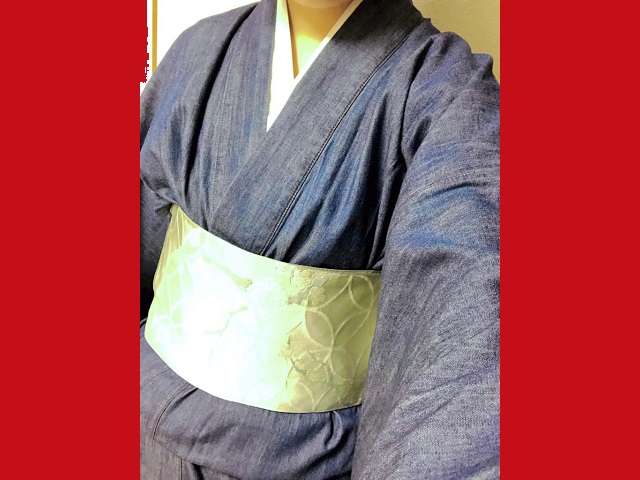
East meets West, but do they get along?
There’s no Japanese garment that’s more Japanese than a kimono. Meanwhile, no other fabric evokes images of the West like denim does, whether the wearer you’re picturing in your mind’s eye is a casually cool American teenager or a literal cowboy.
But can these two fashion icons from opposite sides of the Pacific work together? That was the question that our Japanese-language reporter Udonko has been turning over in her head recently, and she decided that the best way to find out would be to buy a denim kimono to see for herself how it looks and feels.
After a bit of online searching, Udonko settled on a denim kimono from maker Tayu-Tafu. Purchased together with a reversible obi (sash), the bundle came to 8,525 yen (US$78), a very reasonable price when either a kimono or obi alone can easily cost tens of thousands of yen.
This is actually the first kimono Udonko has ever bought for herself, so she also picked out a nagajuban, from manufacturer Kirakukai, for 2,200 yen. The nagajuban is an undergarment you put on first so that the kimono itself isn’t in direct contact with your skin, keeping sweat and body oil away to help keep it clean. This nagajuban is made of polyester and is machine washable.
Finally, Udonko picked up a pack with various pads and cords to help keep the kimono and sash smooth and in place, both while putting the garments on and while wearing them. She paid 3,520 yen, but not each and every item in the pack is absolutely essential, and just like with the sash and nagajuban, if you’re not a complete kimono neophyte you might already have everything you need.
Tayu-Tafu offers denim kimono in a variety of shades of blue, and Udonko opted for a moderate not-too-dark, not-too-light color.
While this wasn’t Udonko’s first time to wear a kimono, it was her first time to tie the sash all by herself. Particularly for women’s kimono sashes there are many, many different ways to tie them, and some enthusiasts sign up for special kimono classes to learn how to create the most extravagant styles. Udonko, though, opted for the method called karuta musubi, or “card tying,” which uses simple straight folds, and after watching a YouTube demonstration, she found it wasn’t much harder than a basic origami pattern.
With the obi tied, Udonko looked at her reflection in the mirror, and to her pleasant surprise, found that her denim kimono doesn’t look strange at all, and is actually quite fashionable in its own unique East-meets-West way.
However, appearance wasn’t Udonko’s only concern. Traditional kimono are made of silk or cotton, which tend to be lighter, more flexible materials than denim, so would her denim kimono be difficult to move around in?
To find out, she performed what seemed like the most appropriate test for a type of clothing strongly associated with the age of samurai: seeing if she could draw a katana while wearing it…and she’s happy to report that this presented no problems whatsoever!
▼ No ninja assassins will be getting the drop on Udonko while she’s dressed in her denim kimono (nor will they be able to identify her as their target).
Given the garment’s eclectic nature, she figured a more modern test was in order as well, so she followed up the unsheathing trial by…
…bouncing up to perform the Uma-pyoi Densetsu dance from horse-girl anime/video game phenomenon Uma Musume.
Once again, the denim kimono passed with flying colors. Granted, it doesn’t allow for a full range of motion for your legs (so she probably won’t be wearing it on her next Kyoto mountain temple hike), but that’s true of any kimono, regardless of the material, since the fabric is cut, and the sash tied, in a way to prevent the robe from coming open and leaving you exposed below the waist.
Not only does the denim kimono look good and feel good, Udonko thinks it also opens up whole new avenues for kimono fashion coordination. Because of denim’s modern, relaxed image, she’s thinking of pairing her demin kimono with comfy sneakers for outings that involve enough walking that they’d be painful in traditional sandals, or maybe sporting a turtleneck underneath the robe once the weather turns cooler. She might even start wearing her denim kimono around the house, since it’s actually pretty warm and cozy, and now we can’t help thinking it’d also look great with one of those Pokémon haori coats worn over it too.
Related: Tayu-Tafu denim kimono, Kirakukai nagajuban
Photos ©SoraNews24
● Want to hear about SoraNews24’s latest articles as soon as they’re published? Follow us on Facebook and Twitter!
[ Read in Japanese ]